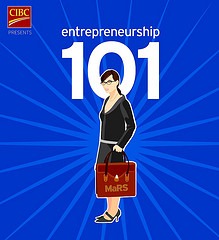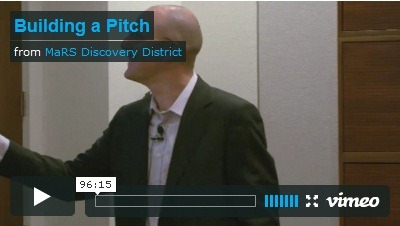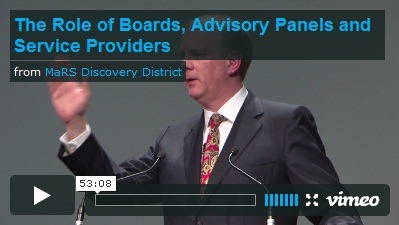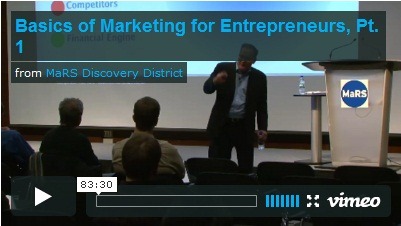- watch TED xToronto live now – http://bit.ly/XPdEZ powered by Toronto startup http://www.epresence.tv #
-
Weekend Reading
-
Entrepreneurship 101 starts Sept 30, 2009
 MaRS is continuing it’s Entrepreneurship 101 program for the 2009-2010. Entrepreneurship 101 is an introductory program aimed at providing the “nuts and bolts of building a business”. The program is a 16 week program aimed at providing the basics around starting a company. Topics include:
MaRS is continuing it’s Entrepreneurship 101 program for the 2009-2010. Entrepreneurship 101 is an introductory program aimed at providing the “nuts and bolts of building a business”. The program is a 16 week program aimed at providing the basics around starting a company. Topics include: - financing
- defining markets
- hiring teams
- protecting intellectual property
- raising capital
MaRS has done a great job publishing a Vimeo channel with all of the past content. These build on our Teaching Entrepreneurship with a local opportunity for Toronto entrepreneurs. This is a great way to see the theoretical side of entrepreneurship, but to gain exposure to entrepreneurial thinking and the basics of getting off the ground.

Building a Pitch from MaRS Discovery District on Vimeo.
The Role of Boards, Advisory Panels and Service Providers from MaRS Discovery District on Vimeo.
Basics of Marketing for Entrepreneurs, Pt. 1 from MaRS Discovery District on Vimeo.
Basics of Marketing for Entrepreneurs, Pt. 2 from MaRS Discovery District on Vimeo. -
Founders versus early employees
Not everyone can be a founder. We talk about the founders of startups and companies. We focus on the founders. The founders get press coverage. They get invited to speak at events. Sometimes they get rich. But for every founder, there is an early employee that takes near equal risks in joining an early-stage company.
Steve Blank divides the individuals associated with startups as:
- Founders
- Early Employees (Employees # 1-25)
- Later Employees (Employees # 26-125)
The majority of his division is about the temperament of the individual as related to risk and dealing with chaos and uncertainty. Not every one can be a founder, i.e., can you imagine trying to start a company with 10,000 people? It’s just unfeasible.
“Being an early hire at a startup gives an individual the ability to make tremendous impact on an organization as it grows – and both the founders and those hires should know it.” David Beisel
We need to celebrate the employees at startups. We need to make sure that early employees are compensated, incented and rewarded for their decisions to join startups. Early employees have a huge impact on the growth and culture of a company.
How do you compensate early employees? Paul Graham provides a model for calculating value. As Naval points out that you still need to pay employees market rates, but with all employees you need to ask yourself “whether she [a new hire] is likely to increase the next round’s share price”. This should force companies to think about building value with each early hire, and not just filling a position.
Title Range (%) CEO 5 – 10 COO 2 – 5 VP 1 – 2 Independent Board Member 1 Director 0.4 – 1.25 Lead Engineer 0.5 – 1 5+ years experience Engineer 0.33 – 0.66 Manager or Junior Engineer 0.2 – 0.33 Table 1: Options Grants in Silicon Valley for Series A from VentureHacks
The numbers from VentureHacks are guidelines. They are rough estimates.Any one have sample option grants in Canada? Are the percentages different? I would assume that they are very similar but given the lower valuations and this may change the salary/options mix.
Remember the goal is to incent early employees to have an emotional ownership of the product and company they are building. Equally said, potential employees need to understand what they are getting into. Darmesh Shah has a great list of insights for employees joining early stage companies. Early employees are critical for startups, and we need to recognize that not everyone can be a founder.
I would love to hear your thoughts on being a founder or an early employee.
Additional Resources
-
Weekend Reading
- NowPublic acquired for $20-25M by Examiner.com http://bit.ly/A7yXF #
- Canada Pension Plan Investment Board investing $300M in $1.9B private equity deal for Skype – http://bit.ly/DUURj #
- RT @markrmcqueen Industry Minister Tony Clement puts $50MM into Ontario's tech, biotech and venture industry: http://bit.ly/XJTWq #
- Fonolo named to Time.com’s 50 Best Websites 2009 – http://bit.ly/14YcSE #
-
Hire a co-op!
Looking for ways to get new talent? Hire a co-op! The Ontario Government has a great program to help offset the costs. It’s interesting how all of these programs are located in and around Waterloo. This is one of the benefits of starting a company in Ontario.
I know that Kontagent, Extreme VP, Bumptop, LearnHub, Sysmos, FreshBooks, Well.ca, Idee and others have hired co-ops in the past. Here is some basic math, pay your students $15/hour for a 40 hour week for 16 weeks. It will cost you $9,600. The program will return you 25% which is $2,400. Cost for you for the 16 weeks is only $7,200. A steal!
For each co-op student hired, your organization can take advantage of the Co-operative Education Tax Credit. The Ontario Government recently increased the credit to 25 per cent of salaries or wages and benefits (30 per cent for small businesses) to a maximum of $3,000 per student, per term. For more
information:- Conestoga College: +1-519-748-5220 ext. 2374 or [email protected]
- University of Waterloo: 1-877-928-2667 or [email protected].
- Wilfrid Laurier University, +1-519-884-0710 ext. 4484
- University of Guelph, +1-519-824-4120 ext. 52323
Anyone know the contact details for UofT, Seneca, or Ryerson’s coop programs?
-
Teaching Entrepreneurship
The first book I remember reading about starting a new tech venture was High-Tech Ventures: The Guide for Entrepreneurial Success. It is a book that was written about entrepreneurial ventures in the mid to late 1980s. Surprisingly much of the advice and particularly the venture economics remains valid. However, much of the manufacturing and marketing advice doesn’t apply 18 years later. The good news is that there are a ton of online resources that are available to round out the education for entrepreneurs.
It’s great to see that Velocity, SIFE and Impact are making it easier for students to learn about entrepreneurship as a career path. Maybe I need to put some effort into adding content to StartupSchool.ca to make a valuable resource for entrepreneurs and students.
- MIT Open Course Ware
- 15.351 Managing Innovation and Entrepreneurship
- 15.352 Managing Innovation: Emerging Trends
- 15.391 Early Stage Capital
- 15.394 Designing and Leading the Entrepreneurial Organization
- 15.615/15.647 Law for the Entrepreneur and Manager
- 15.431 Entrepreneurial Finance
- 15.835 Entrepreneurial Marketing
- 15.821 Listening to the Customer
- 15.818 Pricing
- 15.975 The Nuts and Bolts of Business Plans
- 15.912 Technology Strategy
- 15.389 G-Lab: Global Entrepreneurship Lab
- MaRS
- Stanford University
- Carnegie Mellon University
- MIT Open Course Ware
-
GigPark.com acquired by CanPages
 It’s hard not to like Pema and Noah. The two founders of GigPark have been two of the hardest working and (more importantly) most focused founders to have come out of Toronto in the last few years.
It’s hard not to like Pema and Noah. The two founders of GigPark have been two of the hardest working and (more importantly) most focused founders to have come out of Toronto in the last few years.We first covered GigPark in February 2008. I loved the site, and the focus on maintaining the integrity of the social network, but I wondered whether they could build the mass needed to go from walled garden to healthy ecosystem. Then, earlier this year GigPark partnered with Metro, a free national newspaper.
Today CanPages is announcing that they have acquired GigPark. The deal also received a nice mention in the Globe and Mail.
Pema and Noah are examples of what a laser focus on product will get you. They released early and they continued to develop GigPark with regular releases and improvements. The key here though is that they got the product out early and didn’t try to come up with the perfect product from day one.
When I first started using GigPark, I didn’t remember to go back to the site regularly, but over time GigPark became an integral part of how I found new places to eat and businesses to call. As my network slowly grew, it became not just useful, but critical.
I am feeling especially proud to know these guys and to have had the chance to watch them grow from first release to acquisition. They have been behind-the-scene supporters of a lot of the community and have always encouraged the entire Toronto community.
Noah and Pema will be staying in the CanPages family for a little while, but I am sure it won’t be long before they are back in action.
-
Weekend Reading
- Albert Lai, Farewell Bubbleshare – http://bit.ly/9gQ2P #
- FreshBooks featured in the Globe and Mail – http://tinyurl.com/qtfwl8 #
- Waterloo based RapidMind has been acquired by Intel http://www.rapidmind.net/company.php #
-
Pitching fastballs
“Do you have some time for a coffee or beer to chat about my startup?” – Anonymous entrepreneur
I’m happy to talk to entrepreneurs, learn about your startup and even help you out if I can. Since I have a bad habit of over committing and taking on too many activities. Let’s see there’s DemoCamp, Founders and Funders, StartupEmpire, my job (yes, I work at Microsoft), and a personal life (think 2 kids under the age of 2). Things are chaotic and busy, I’m starting to ask entrepreneurs to help me. So without more information, the answer to the above question is “maybe, help me understand why we should me”.
This sounds familiar. It’s similar to the problem faced by investors (made more pronounced with time-constrained applications), and journalists, and customers.
“If we get 1000 applications and have 10 days to read them, we have to read about 100 a day. That means a YC partner who reads your application will on average have already read 50 that day and have 50 more to go.” – YCombinator How To Apply
We talk about an Elevator Pitch. Except this isn’t a world where you might have forced my focus of attention by being artificially trapped in an elevator. The goal is like a newspaper headline. It’s to make me read the rest of the story. You need to stand out. You have to be able to simply, clearly convey what your startup is going to do. The YCombinator team do a great job describing what they look for in How To Apply. The initial filtering criteria for a YC application are obviously different than the criteria that journalists use to find stories, and different that what I use when determining to take a meeting or how I can help a startup. But the process is the same.
“What is your company going to make?" This isn’t the question I care most about, but I look at it first because I need something to hang the application on in my mind.
The best answers are the most matter of fact. It’s a mistake to use marketing-speak to make your idea sound more exciting. We’re immune to marketing-speak; to us it’s just noise.” – YCombinator How To Apply
This is about stand out from the pack. And helping the reader/journalist/audience member figure out who you matter to and why. Think of this as demand generation. You’re driving awareness and interest in your company, your team, your solution. The number one key is to be empathetic to the person whose attention and imagination you are trying to capture. Put yourself in the shoes of your intended audience, and help them understand what is special about your company, your product, you.
“Boil down your elevator pitch to one sentence. Tell us what you sell or do in very concrete language. This sets the context for the rest of your presentation.” – David Rose
Here’s an attempt to write that opening description for a few local startups.
- FreshBooks is a QuickBooks killer. It is a web-based accounting system allows small businesses to have accurate, professional estimates, time tracking, and invoicing.
- Well.ca is Canada’s online drugstore. Strong sales growth over past 3 years, raised $1.1M from angel investors in July 2009, technology focused with strong customer service.
- Rypple is a web application that gathers anonymous feedback from anyone. Peter Thiel is an investor. Founders have a strong track record at Workbrain.
- Dayforce is an rich internet application and web service that allows managers to visualize and plan their employees schedules and the employees to enter their timesheets. Founders have strong track record including Workbrain.
- Kiiro is a social project management application built on SharePoint. It uses the web and Microsoft Project to improve collaboration between the project managers and the team on larger projects.
- CoverItLive is web application for live blogging events. Companies, conferences, individuals can connect photos, tweets, live video, and rich media during events.
This is just the beginning. But that is the point. The goal is to entice the reader to want to know more. Ideally I’d love to see a short description of what you’re building. A clear identification about how you think you’re going to make money. What you think your secret sauce is. And a brief summary of key team members. Sound familiar. It’s very similar to the advice that David Rose provides as a Pitch Coach. The goal is to take basic pitch information and digest it into a smaller, customized components for your audience. It means that entrepreneurs are going to have stop being ego-centric and start thinking about others. You need to understand what is important to the individual that you are trying to reach and to shape your message appropriately.
For me, I want to understand what your company does/builds; the management team; the market opportunity; the business model; the stage of corporate development (pre-funded, funded, pre-revenue, etc.); why you think I care about this; and what your ask is of me. Is that too much to ask?
Open challenge to local startups to “pitch” for a meeting in a 140 characters or less in the comments (more realistically less than 420 characters – basically 3 tweets).
Resources
-
StartupDrinks – August 26, 2009
Updates
- ExtremeU Social is happening on August 26 from 5-7pm. Start out on the patio at Extreme Ventures with the ExtremeU companies and then head over to StartupDrinks at C’est What?
- Montreal RSVP at TechEntreprise. Happening at Brutopia.
- Ottawa RSVP at Guestlistapp. Happening at Metropolitan Brasserie.
It’s time again.

Bryan Watson of NACO and Robin Ahn of CEOFusion have stepped up to help coordinate the next installment of StartupDrinks in Toronto. Heri of Montreal Tech Watch and Raymond Luk of Flow Ventures are hosting the Montreal event. And Scott Annan from Mercury Grove is stepping up to host an Ottawa event.
The kickoff Toronto Startup Drinks followed hot on the heels of DemoCamp and was a great event. We are keeping the startup community alive, one pint at a time on Wednesday, August 26, 2009 at local fave C’est What!
It’s a simple concept: a grassroots effort to make sure startup folks get in touch and stay in touch.
Toronto
- Date: Wednesday, 26 August, 2009
- Location: C’est What, 67 Front Street East, Toronto, ON (map)
- Time: 6pm until late
- Sign up using Guestlistapp, then join us on the night for a to meet other entrepreneurs!
Montreal
- Date: Wednesday, 26 August, 2009
- Location: Brutopia, 1219 Rue Crescent, Montreal, QC (map)
- Time: 6pm until late
- Sign up at TechEntreprise, then join us on the night for a to meet other entrepreneurs!
Ottawa
- Date: Wednesday, 26 August, 2009
- Location: Metropolitan Brasserie, 700 Sussex Dr., Ottawa, ON (map)
- Time: 6pm until late
- Sign up using GuestListApp, the join the gang at the Metropolitan.
Everyone is welcome.